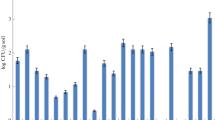Summary
A ‘most probable number’ method is described, using paper chromatography, for enumerating bacteria which produce 2-ketogluconic acid in soils and other habitats. Using this method it has been shown that highest numbers of this group of organisms are associated with habitats rich in organic matter. An enhancement of this group of organisms in the rhizosphere of barley plants has been demonstrated and also a marked stimulation around starch-containing pellets buried in soil.
Similar content being viewed by others
References
Allen, O. N., Experiments in Soil Bacteriology, p. 127. Burgess Publishing Company, Minneapolis (1957).
Brockwell, J., Non-infective nodule bacteria in peat culture. J. Australian Inst. Agr. Sci.20 243 (1954).
Brown, M. E., Burlingham, S. K. and Jackson, R. M., Studies onAzotobacter species in soil 1. Comparison of media and techniques for countingAzotobacter in soil. Plant and Soil17, 309 (1962).
Buchanan, R. E. and Fulmer, E. I., Physiology and Biochemistry of Bacteria1, p. 12. Williams and Wilkins, Baltimore (1928).
Duff, R. B. and Webley, D. M., 2-Ketogluconic acid as a natural chelator produced by soil bacteria. Chem. Ind.1959, 1376 (1959).
Duff, R. B., Webley, D. M. and Scott, R. O., Solubilization of minerals and related materials by 2-ketogluconic acid-producing bacteria. Soil Sci.95, 105 (1963).
Glentworth, R. and Muir, J. W., The Soils of the country round Aberdeen, Inverurie and Fraserburgh. Mem. Soil Surv. Scot., Edinburgh. H.M.S.O. (1963).
Louw, H. M. and Webley, D. M., A study of soil bacteria dissolving certain mineral phosphate fertilizers and related compounds. J. Applied Bacteriol.22, 227 (1959).
Louw, H. M. and Webley, D. M., The bacteriology of the root region of the oat plant grown under controlled pot culture conditions. J. Applied Bacteriol.22, 216 (1959).
Maloy, O. C. and Alexander, M., The “most probable number” method for estimating populations of plant pathogenic organisms in the soil. Phytopathology48, 126 (1958).
Prescott, S. C., Winslow, C. E. A. and McCardy, M. H., Water Bacteriology, p. 368. John Wiley & Sons. Inc. New York (1946).
Rowatt, J. W. and Katznelson, H., A study of the bacteria on the root surface and in the rhizosphere of crop plants. J. Applied Bacteriol.24, 164 (1961).
Taylor, J., The estimation of numbers of bacteria by tenfold dilution series. J. Applied Bacteriol.25, 54 (1962).
Webley, D. M. and Duff, R. B., A technique tor investigating localized microbial development in soil. Nature194, 364 (1962).
Webley, D. M., Henderson, M. E. K. and Taylor, I. F., The microbiology of rocks and weathered stones. J. Soil Sci.14, 102 (1963).
Author information
Authors and Affiliations
Additional information
the late
Rights and permissions
About this article
Cite this article
Webley, D.M., Duff, R.B. The incidence, in soils and other habitats, of micro-organisms producing 2-ketogluconic acid. Plant Soil 22, 307–313 (1965). https://doi.org/10.1007/BF01373998
Received:
Issue Date:
DOI: https://doi.org/10.1007/BF01373998




